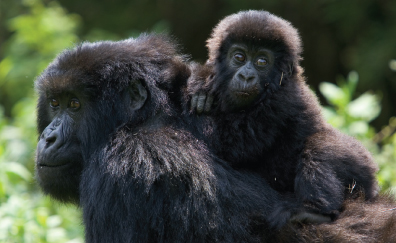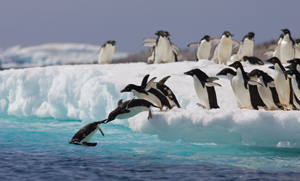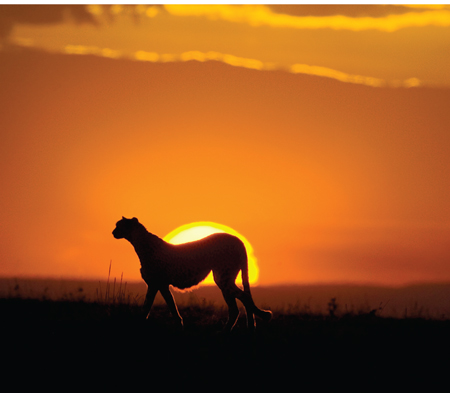Can you recall your career’s happiest moment? Its saddest time? Can’t do it? Tiburon’s Suzi Eszterhas can. And both instances involve animals she was photographing in the wilds of Africa.
“One day while I was working in the Masai Mara, the park rangers brought me a serval kitten. He couldn’t have been more than two weeks old,” Eszterhas says, “and he was an orphan.” She named the cat Moto, and for the next six months she fed and cared for the long-legged spotted animal before returning it to the open grasslands. “Several weeks later, when I was shooting in the same area, I spotted this wild young cat.” The cat walked toward her jeep and the two stared at each other for nearly a minute. “I just knew it was Moto,” she says. “I was so happy; I felt like a very proud mom.”
The saddest moment in the prizewinning wildlife photographer’s career also took place in Kenya’s Masai Mara game reserve and involved five cheetah cubs. “I worked closely with several cheetah families for over two years and fell in love with all of them,” Eszterhas says. She grew especially attached to a litter of five cubs she spent several hours a day with for nearly three weeks. “This was so we could get to know each other. I would photograph them later.” On each visit, she would roll down the windows of her small Suzuki and stand up through the roof hatch. “The cheetahs were several feet away,” she says. “They’re not incredibly difficult to work with; they’re very trusting and definitely they accepted me being there.”
The cheetah is an endangered species, “and cubs are especially threatened,” says Eszterhas, “with a 95 percent chance of not living beyond three months.” After shooting a series of photos, she was devastated to find that three of the cubs had been killed by birds of prey and jackals possibly had carried two off. “Having that beautiful litter disappear before my eyes really affected me,” she says. “And for two days afterward, I heard the mother cheetah crying out for her babies. That was probably the saddest thing in nature I’ve ever experienced.”
Eszterhas, 33, says she knew from age 8 that her life’s work would involve wildlife. “Back then, we lived in San Rafael in an area with forested hills and I was a strange kid. I’d be in my own world feeding skunks and raccoons, then reading about Dian Fossey and Jane Goodall.” After attending Redwood High, she graduated from UC Santa Cruz in 1999 and set out to become a wildlife photographer. “For years, I had a day job at an animal shelter in Santa Cruz,” Eszterhas says. “Then I quit, drained my savings account, flew to Kenya, gained reasonable fluency in Swahili, lived mostly in a tent and wound up staying four years.”
These days Eszterhas travels about seven months of every year but still considers Marin County home. Her photographs regularly appear in such publications as Smithsonian, BBC Wildlife, Scientific American, Ranger Rick and National Geographic Kids. She was named 2008 Wildlife Photographer of the Year by Ranger Rick and has been honored in the prestigious Wildlife Photographer of the Year competition sponsored by BBC Wildlife and London’s Natural History Museum.
Cheetahs
Eszterhas had a subsequent encounter with cheetahs that had a more positive outcome. This time it was a mother and her three cubs, which Eszterhas estimated to be 21 months old. “Cheetahs lead a mostly solitary life,” she says. “The male and female are together only for mating. After the cubs are born, the mother stays with them for nearly two years.” During that time the mother teaches her offspring survival techniques. “For example, a mother will capture a baby gazelle, injure but not kill it, then bring it back to her cubs, so they can kill it and learn to survive.”
In the photo below, the mother cheetah is third from left, looking away from the camera. “I know at first glance it’s hard to tell mother from her cubs,” Eszterhas says, “but just look at the scruff on the backs of their necks. This mom is middle-aged, probably seven years old.” Cheetahs may appear menacing, she adds, but they would run from an intruder rather than attack. The world’s fastest land mammals, cheetahs have been clocked at 65 miles an hour. “A predator on the run is incredibly difficult to photograph,” Eszterhas says. “It took me almost two weeks before I could successfully capture on film a cheetah running down a gazelle.”
Gorillas
 In Rwanda and Uganda, Eszterhas has photographed mountain gorillas, which are the rarest of gorilla subspecies. Found at elevations of 7,000 to 13,000 feet, they live in groups of as many as 40, with a male silverback (named for a distinctive patch of silver hair on its back) acting as group leader. “A silverback can weigh 500 pounds upon reaching maturity at the age of 12 years,” Eszterhas says.
In Rwanda and Uganda, Eszterhas has photographed mountain gorillas, which are the rarest of gorilla subspecies. Found at elevations of 7,000 to 13,000 feet, they live in groups of as many as 40, with a male silverback (named for a distinctive patch of silver hair on its back) acting as group leader. “A silverback can weigh 500 pounds upon reaching maturity at the age of 12 years,” Eszterhas says.
Shooting gorillas is an intimate wildlife experience, she adds. “After you hike in and finally locate a group, gorillas seem to act as if you’re not even there—they pay no attention to photographers. Gorillas are the ideal photo subjects. No long-distance lenses are needed because they’re very mellow; they simply eat, groom each other and sleep.” The biggest worry is keeping at least 20 feet away from the animals to avoid transmitting disease—from you to them.
Penguins
Although Eszterhas works primarily in Africa, she has taken assignments and led instructional photography tours and workshops in the Arctic and Antarctica. In Antarctica, she photographed a lone Adelie penguin that appeared on the cover of Time magazine’s April 9, 2007, special issue on climate change. However, solitary penguins are an exception, not the rule. “There can be 500,000 penguins in one colony and the noise is deafening while the smells are really intense,” Eszterhas says. “The challenge is to get one penguin off all by itself.”
 In a typical Antarctic workshop, Eszterhas and her group travel there by boat from Chile or Argentina and spend a couple of days touring places where penguins gather. “Once we’re there, eight or 10 of us will head out in a Zodiac, get within several feet of a colony and be shooting for most of the day.” Back on the ship, laptop editing and discussions occupy the evenings.
In a typical Antarctic workshop, Eszterhas and her group travel there by boat from Chile or Argentina and spend a couple of days touring places where penguins gather. “Once we’re there, eight or 10 of us will head out in a Zodiac, get within several feet of a colony and be shooting for most of the day.” Back on the ship, laptop editing and discussions occupy the evenings.
Wildlife photography is mostly about shooting fast and developing a sense for what the animals’ reactions will be, says Eszterhas. “It’s not rocket science,” she adds, laughing. “Anticipating what the animal is likely to do next is key.” Of late, her camera of choice has been a Canon EOS 1D Mark III.


